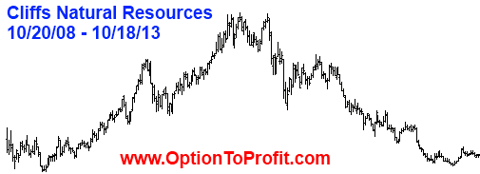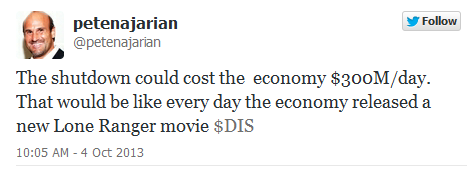 Is there life after momentum slows?
Is there life after momentum slows?
There was no shortage of stocks taking large price hits last week, as earnings season had already begun its slowdown phase. However, for some of the better known momentum stocks the slightest mis-steps were all the reason necessary to flee with profits.
For those who live long enough, it should never come as a surprise that some things are just destined to slow down.
Momentum fits into that category, although based on the past week it’s more of a question of falling down than slowing down for some.
After the fact, no one seemed to be surprised.
In a week that saw a decrease in the ECB’s main lending rate that was widely described as being a “surprise'” later in the day came reports that most economists expected the cut. The market clearly didn’t, however, as the economists may have neglected to pass on their views.
And then there was a surprisingly large increase in non-farm payroll jobs. Somehow everyone was taken off guard and the market responded by interpreting good news as good news and finished the week with a flourish.
What surprised me, however, was that there was such a disconnect between the anticipated numbers and the actual report, which covered the period of the government shutdown. The disconnect had to do with methodology, as forecasts didn’t take into account that government statistics considered furloughed employees to be employed, since they were to receive back, through legislative action.
Oops.
In effect, Friday’s rally was based on a misunderstanding of methodology. It will also certainly be interesting to see what impact Ben Bernanke’s statement after the market’s close may have on Monday’s trading.
I think the unemployment rate probably understates the degree of slack in the labor market. I think the employment-population ratio overstates it somewhat, because there are important downward trends in participation
Unfortunately, Friday’s gains complicate the goal of finding bargain priced stocks in the coming week, but with a little water having been thrown on the fire there may be opportunity yet.
Everyone, including me, likes to look for clues and cues that have predictive value. Parallels are drawn at every opportunity to what we know from the past in the expectation that it can foretell the future.
For some the sudden increase in IPOs coming to market and the sudden fall of many momentum stocks heralds a market top. In hindsight, if it does occur, it will be regarded as “no surprise.” If it doesn’t occur within the attention span of most paying attention it will simply be conveniently ignored.
For others the reversal of fortune may represent values and not value traps.
But no matter what the case there is life after momentum slows. It’s just a question of accommodation to new circumstances.
As usual, the week’s potential stock selections are classified as being in Traditional, Double Dip Dividend, Momentum and “PEE” categories this week (see details).
eBay (EBAY) like so many stocks that I consider tends to trade in a range. While eBay is often criticized for being “range bound” there is some comfort in knowing that it is less likely to offer an unwanted surprise than many other stocks. My shares were assigned this past week and are now trading at the upper range of where I may normally initiate a position. However, having owned shares on ten separate occasions this year I would be anxious to do so again on the slightest of pullbacks.
Although hardly a momentum stock, Mondelez (MDLZ) had some earnings woes this past week, although it did recover a bit, perhaps simply being carried along by a rallying market. Shares are still a little higher than I would like for an entry point, but I expect that as a short term selection it will match market performance, while in a market turn-down it will exceed performance.
Fastenal (FAST) is another fairly sedate company, yet its stock often has some large moves. I see Fastenal as a leading indicator of economic activity, but also very sensitive to the economy. I think its most recent price weakness will be reversed as the impact of a resolution of the government’s shutdown trickles down to the economy. I currently own shares with a contract set to expire this week, but at this price am considering doubling down on what in essence can be a weekly option contract during the final week of the November 2013 cycle.
Deere (DE) is another range bound stock, that in hindsight I should have bought on numerous occasions over the past few months. Good option premiums, a good dividend and not facing some of the same external pressures as another favorite, Caterpillar (CAT), makes Deere a perennially good selection within its sector.
I currently ow
n shares of both Eli Lilly (LLY) and International Paper (IP), both of which go ex-dividend this week. Unlike many other stocks that I discuss, I have not owned either on multiple occasions this year and my current shares are now below their cost. Both emerged unscathed after recent earnings reports, although both are down considerably from their recent highs and both have considerably under-performed the S&P 500 from the time for its first in a series of market highs on May 21, 2013. That latter criterion is one that I have been using with some regularity as the market has continued to reach new highs in an effort to identify potential late comers to the party.
Which finally brings me to the momentum stocks that have my attention this week, some of which may be best approached through the sale of put options and may be best avoided in a weakening market.
Much has been said of the “ATM effect” on Facebook (FB), as speculation that investors were selling Facebook shares to raise money to buy Twitter (TWTR) shares. Following an abrupt reversal during its conference call when there was a suggestion that adolescents were reducing their Facebook use shares have just not regained their traction. Sometimes it’s just profit taking and not driven by the allure of a newer stock in town. But assuming that the “ATM effect” has some validity and with a large gap between the Twitter IPO price and its 7% lower price on its first full day of trading, I can’t imagine now taking the opportunity to sell Facebook in order to purchase Twitter shares. On its own merits Facebook may be a momentum stock that has a cushion of protection until its next earnings report, unless an errant comment gets in the way, again.
Chesapeake Energy (CHK) is much higher than the level at which I last owned shares at $21. Waiting for a return has been fruitless and as a result, rather than having owned shares on 15 occasions, as in 2012, thus far, I’ve only had five bouts of ownership. With the melodrama surrounding its founder and ex-CEO in its past, Chesapeake may begin trading a bit more on fundamentals rather than hopes for a return to its glory days. at such, its price action may be less unidirectional than it has been over the past four months. After last week’s earnings report related drop, while still higher than I would like, I think there may be reason to consider a new entry, perhaps through the sale of put options.
Freeport McMoRan (FCX) is a stock that has been testing my patience through the year. More precisely, however, I’ve had no real issue with Freeport McMoRan’s leadership, in fact, given metal prices, it has done quite well. What I don’t understand is how it has been taking so long for markets to appreciate its strategic initiatives and long term strategies. For much of the year my shares have been non-performing, other than for dividend payments, but with a recent run higher some are generating option premium income streams. Despite the run higher, I am considering adding more shares as the entire metals complex has been showing strength and some stability, as well.
Finally, while I’ve said before that I don’t spend too much time looking at charts, a recent experience with Tesla (TSLA) was perhaps a good reason to at least acknowledge that charts can allow you to look at the past.
While it’s probably always a good week to be Elon Musk, relatively speaking last week wasn’t so good, as both Tesla and Solar City (SCTY) were treated harshly after earnings were released. The spin put around another reported car fire that its resultant heat could be garnered to power several mud huts didn’t give shares much of a boost, perhaps because that might have cannibalized SolarCity sales, with the two companies likely having much overlap in ownership.
Tesla reported earnings last week and took a drubbing through successive days.
A reader of last week’s article asked:
“George, what are your thoughts on a sale of Puts on TSLA which reports Tuesday?”
My response was:
“TSLA isn’t one that I follow, other than watching in awe.
But purely on a glance at this week’s option pricing the implied volatility is about 12% and you can get a 1% ROI on a strike that’s about 17% lower, currently $135
It looks as if it may have price support in the $134-$139 range, but it’s hard to know, because its ascent has been so steep that there may not be much of a real resting point.
In a very speculative portion of my portfolio I might be able to find some money to justify that trade.”
As it turned out Tesla closed the week at $137.95 and now has my attention. You do have to give some credit to its chart on that one. WIth disappointment over its sales, supply chain issues and reports of car fires and even Elan Musk suggesting that “Tesla’s stock price is more than we have any right to deserve,” it has fallen by nearly 21% from the time of that comment, barely 2 weeks prior to earnings. Although to be entirely fair shares did fully recover from a 7.5% decline in the aftermath of the statement in advance of earnings.
While still not knowing where the next resting point may be in the $119-$122 range, representing as much as another 13% price drop. With earnings out of the way to
enhance option premiums the risk-reward proposition isn’t as skewed toward reward. However, for those looking to recapture of bit of their own momentum, despite the realization that the end may be near, a put sale can return an ROI of approximately 1.4% at a strike price nearly 6% below Friday’s close is not breached.
The nice thing about momentum slowing is that if you fall the floor isn’t as far away as it used to be.
Traditional Stocks: Deere, eBay, Fastenal, Mondelez
Momentum Stocks: Chesapeake Energy, Facebook, Freeport McMoRan, Tesla
Double Dip Dividend: Eli Lilly (ex-div 11/13), International Paper (ex-div 11/13)
Premiums Enhanced by Earnings: none
Remember, these are just guidelines for the coming week. The above selections may become actionable, most often coupling a share purchase with call option sales or the sale of covered put contracts, in adjustment to and consideration of market movements. The overriding objective is to create a healthy income stream for the week with reduction of trading risk.
Disclosure: I am long CAT, CHK, DE, FAST, FCX, IP, LLY. I wrote this article myself, and it expresses my own opinions. I am not receiving compensation for it (other than from Seeking Alpha). I have no business relationship with any company whose stock is mentioned in this article.
Views: 11


 With the S&P 500 having reached an all time high this past week you could certainly draw the conclusion that a government shutdown is a good thing and flirting with default is a constructive strategy. At a reported cost of only $24 Billion associated with closure and nothing more than a symbolic “Fitch slap” credit watch issued, perhaps we should look forward to the next potential round in just a few months.
With the S&P 500 having reached an all time high this past week you could certainly draw the conclusion that a government shutdown is a good thing and flirting with default is a constructive strategy. At a reported cost of only $24 Billion associated with closure and nothing more than a symbolic “Fitch slap” credit watch issued, perhaps we should look forward to the next potential round in just a few months.
 This week I’m choosing “risk on.”
This week I’m choosing “risk on.” This is the time of year that one can start having regrets about the way in which votes were cast in prior elections.
This is the time of year that one can start having regrets about the way in which votes were cast in prior elections.  Pete Najarian put it in terms readily understandable, much more so than when some tried expressing the cost of a shutdown in terms of drag on quarterly GDP.
Pete Najarian put it in terms readily understandable, much more so than when some tried expressing the cost of a shutdown in terms of drag on quarterly GDP. “There’s always a calm before the storm” is a fairly well known saying that doesn’t always accurately define a sequence of events.
“There’s always a calm before the storm” is a fairly well known saying that doesn’t always accurately define a sequence of events.  Generally, when you hear the words “perfect storm,” you tend to think of an unfortunate alignment of events that brings along some tragedy. While any of the events could have created its own tragedy the collusion results in something of enormous scale.
Generally, when you hear the words “perfect storm,” you tend to think of an unfortunate alignment of events that brings along some tragedy. While any of the events could have created its own tragedy the collusion results in something of enormous scale. 


You must be logged in to post a comment.